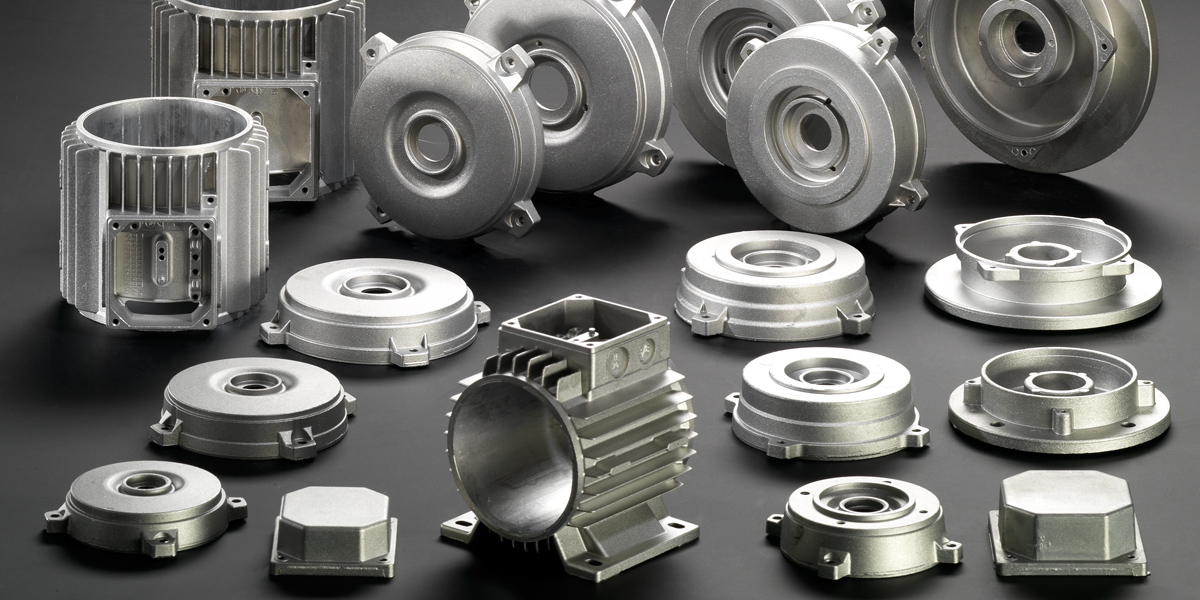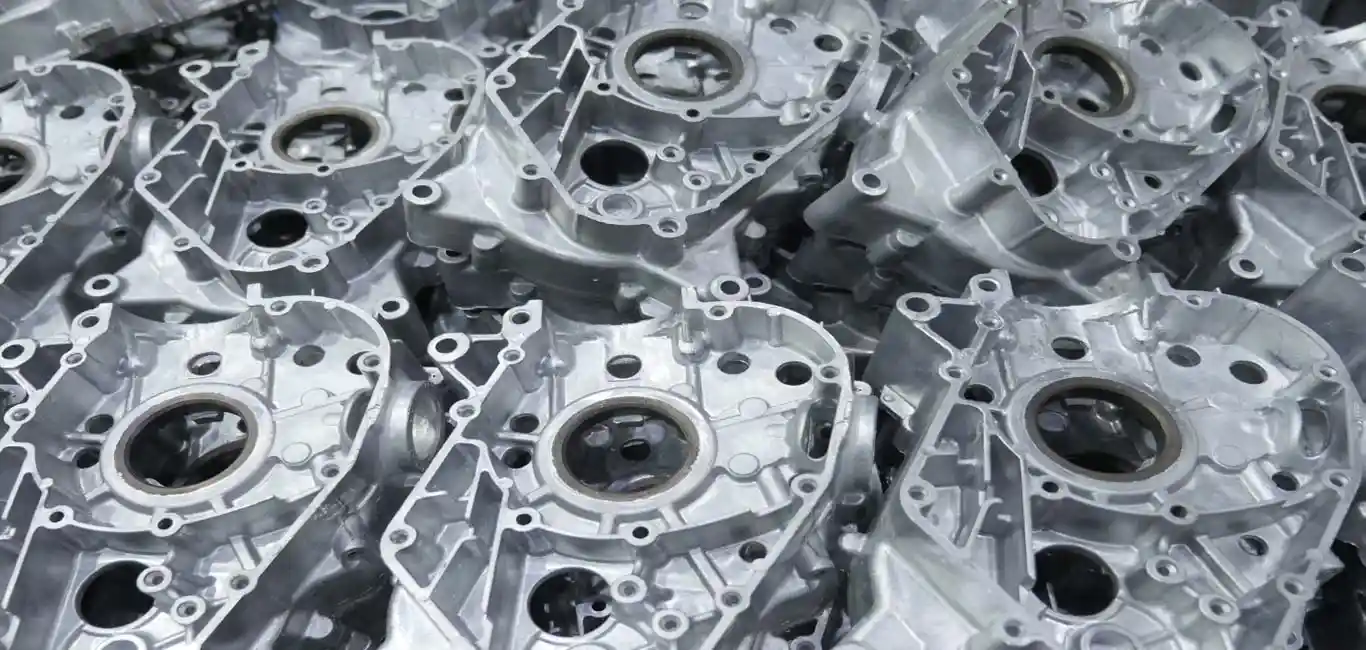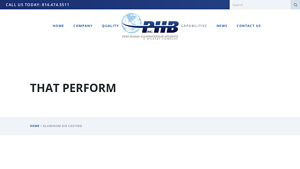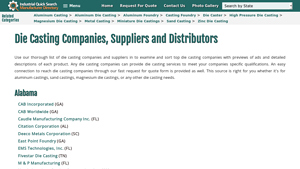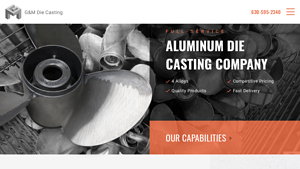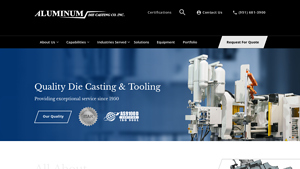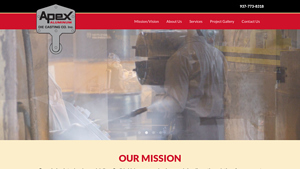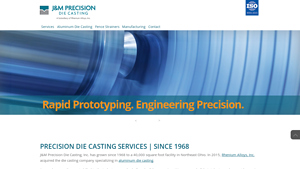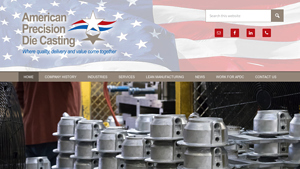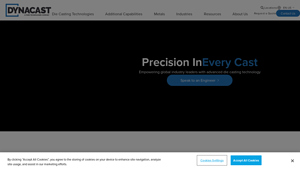Aluminium Die Casting Companies Guide: Type, Cost, Top List…
Introduction: Navigating the Global Market for aluminium die casting companies
In today’s competitive landscape, sourcing high-quality aluminum die casting components can pose significant challenges for international B2B buyers. With a myriad of manufacturers to choose from, businesses must navigate varying standards, capabilities, and pricing structures to ensure they select a reliable supplier. This guide is designed to streamline the process, offering valuable insights into the diverse types of aluminum die casting methods, their applications across various industries, and best practices for supplier vetting.
By delving into essential topics such as cost factors, production capacities, and quality certifications, this comprehensive resource empowers decision-makers from Africa, South America, the Middle East, and Europe—countries like Vietnam and Germany—to make informed purchasing decisions. Understanding the nuances of the aluminum die casting market not only enhances procurement efficiency but also minimizes risks associated with quality and delivery timelines.
As you explore this guide, you will gain the knowledge needed to evaluate potential partners effectively, ensuring that your company secures the best possible solutions tailored to your specific requirements. Whether you’re looking for precision parts for the automotive sector or durable components for electronics, the insights provided here will help you navigate the global market with confidence and clarity.
Understanding aluminium die casting companies Types and Variations
| Type Name | Key Distinguishing Features | Primary B2B Applications | Brief Pros & Cons for Buyers |
|---|---|---|---|
| High-Pressure Die Casting | Utilizes high pressure to inject molten aluminum into molds. | Automotive, aerospace, electronics | Pros: High precision and surface finish. Cons: Higher initial tooling costs. |
| Low-Pressure Die Casting | Employs lower pressure for a gentler casting process. | Industrial components, large parts | Pros: Reduced defects and better material flow. Cons: Slower production rates. |
| Gravity Die Casting | Relies on gravity to fill the mold, often using sand molds. | Decorative items, non-critical components | Pros: Lower cost and simpler tooling. Cons: Less precision and finish quality. |
| Vacuum Die Casting | Uses vacuum to prevent air pockets during the casting process. | High-performance applications, medical parts | Pros: Superior quality and integrity. Cons: More complex setup and higher costs. |
| Die Casting with CNC Machining | Combines die casting with CNC machining for precision parts. | Complex machinery, aerospace components | Pros: Exceptional accuracy and finish. Cons: Increased lead time and cost. |
What Are the Characteristics of High-Pressure Die Casting Companies?
High-pressure die casting companies are characterized by their ability to produce intricate and precise components through the injection of molten aluminum at high pressure. This method is particularly suited for high-volume production runs, making it ideal for industries such as automotive and aerospace. When purchasing from these companies, B2B buyers should consider the initial tooling costs and the potential for quick turnaround times, as well as the need for stringent quality control to ensure part integrity.
How Do Low-Pressure Die Casting Companies Operate?
Low-pressure die casting companies operate by utilizing lower pressure to fill molds, which allows for a more controlled flow of molten aluminum. This method is often used for larger components where dimensional accuracy is still essential. B2B buyers should weigh the benefits of reduced defects and improved material flow against the slower production rates and longer lead times associated with this process.
What Is Unique About Gravity Die Casting Companies?
Gravity die casting companies typically use gravity to fill the molds with molten aluminum, often employing sand molds for simpler designs. This method is less expensive and easier to set up, making it suitable for decorative items or non-critical components. Buyers should consider the trade-off between lower costs and the potential for less precision and finish quality, which may not meet the requirements of more demanding applications.
Why Choose Vacuum Die Casting Companies?
Vacuum die casting companies use a vacuum environment to eliminate air pockets during the casting process, resulting in superior quality and material integrity. This method is particularly advantageous for high-performance applications, such as medical parts or aerospace components. B2B buyers should evaluate the higher costs and complexity of the setup against the significant benefits of enhanced product quality and reliability.
How Do Die Casting with CNC Machining Companies Enhance Precision?
Companies that combine die casting with CNC machining provide a unique advantage by integrating precision machining into the die casting process. This approach is ideal for producing complex machinery parts and aerospace components that require exceptional accuracy and surface finish. Buyers should be mindful of the increased lead times and costs associated with this method, while also recognizing the value of high-quality, tailored solutions for their specific needs.
Key Industrial Applications of aluminium die casting companies
| Industry/Sector | Specific Application of Aluminium Die Casting Companies | Value/Benefit for the Business | Key Sourcing Considerations for this Application |
|---|---|---|---|
| Automotive | Production of engine blocks and transmission housings | High strength-to-weight ratio enhances vehicle efficiency | Certification standards, tooling capabilities, and lead times |
| Aerospace | Manufacturing components for aircraft structures | Lightweight parts improve fuel efficiency and performance | Compliance with aviation standards, precision engineering |
| Consumer Electronics | Casings for electronic devices and appliances | Aesthetic appeal and thermal management | Custom design capabilities, surface finish options |
| Industrial Equipment | Housing for motors and pumps | Durability and resistance to corrosion | Volume requirements, rapid prototyping, and material specs |
| Medical Devices | Custom enclosures for diagnostic equipment | Ensures reliability and safety in critical applications | Regulatory compliance, precision tolerances, and delivery timelines |
How Are Aluminium Die Casting Companies Used in the Automotive Sector?
In the automotive industry, aluminium die casting companies play a pivotal role in producing lightweight yet durable components such as engine blocks and transmission housings. These parts benefit from aluminium’s high strength-to-weight ratio, which enhances overall vehicle efficiency and performance. International buyers must consider certification standards, tooling capabilities, and lead times to ensure that their suppliers can meet stringent automotive manufacturing requirements.
What Role Do Aluminium Die Casting Companies Play in Aerospace Manufacturing?
Aerospace applications require precision-engineered components that adhere to strict safety and performance standards. Aluminium die casting companies supply lightweight parts for aircraft structures, which contribute to improved fuel efficiency and overall performance. Buyers from regions like Europe and the Middle East should focus on suppliers that comply with aviation standards and can demonstrate expertise in precision engineering to ensure the reliability of critical components.
How Are Aluminium Die Casting Solutions Applied in Consumer Electronics?
In consumer electronics, aluminium die casting is utilized for producing casings for devices and appliances. These casings not only offer aesthetic appeal but also provide effective thermal management, ensuring that devices operate efficiently without overheating. Buyers looking for custom solutions should prioritize suppliers with strong design capabilities and a variety of surface finish options to meet their specific product requirements.
Why Are Aluminium Die Casting Companies Important for Industrial Equipment?
Aluminium die casting companies contribute significantly to the industrial equipment sector by manufacturing durable housings for motors and pumps. These components are designed to withstand harsh environments and resist corrosion, enhancing the longevity of the equipment. When sourcing these parts, businesses should consider volume requirements, rapid prototyping capabilities, and material specifications to ensure that their needs are met effectively.
How Do Aluminium Die Casting Companies Support Medical Device Manufacturing?
In the medical device sector, aluminium die casting companies provide custom enclosures for diagnostic equipment, ensuring reliability and safety in critical applications. The need for precision tolerances and adherence to regulatory compliance is paramount in this industry. International buyers must evaluate suppliers based on their ability to meet these stringent standards and their capacity to deliver on time, as delays can have serious implications in the medical field.
3 Common User Pain Points for ‘aluminium die casting companies’ & Their Solutions
Scenario 1: Challenges with Quality Assurance in Aluminum Die Casting
The Problem: One of the most significant challenges B2B buyers face when engaging with aluminum die casting companies is ensuring consistent product quality. Many buyers report instances where the delivered castings do not meet the specified tolerances or surface finish requirements. This inconsistency can lead to costly rework, delays in production schedules, and strained relationships with end customers. Buyers often feel overwhelmed by the need to inspect each batch thoroughly, which can be time-consuming and resource-intensive.
The Solution: To mitigate quality issues, buyers should prioritize working with aluminum die casting companies that have robust quality assurance protocols in place. It is essential to conduct thorough research and vet potential suppliers by reviewing their certifications (such as ISO 9001 or other relevant quality standards) and understanding their quality control processes. Furthermore, engaging in initial prototype testing can help establish benchmarks for quality. Buyers should also consider leveraging technology, such as automated inspection systems, to streamline the quality assurance process. Establishing clear communication channels regarding quality expectations and maintaining regular feedback loops with the supplier can foster a collaborative environment that enhances product quality over time.
Scenario 2: Long Lead Times Affecting Production Schedules
The Problem: B2B buyers often encounter long lead times when ordering aluminum die cast components, which can jeopardize their production timelines. Delays in the casting process can stem from various factors, including mold design complications, material shortages, or inefficient production processes. Buyers frequently express frustration over the unpredictability of delivery schedules, which can disrupt their supply chains and impact their ability to fulfill customer orders promptly.
The Solution: To address lead time challenges, buyers should adopt a proactive approach by discussing production timelines upfront with aluminum die casting companies. It’s crucial to specify delivery requirements clearly during the initial negotiations. Additionally, buyers can opt for suppliers with advanced manufacturing capabilities, such as those utilizing robotics and automation, which can significantly reduce cycle times. Implementing a just-in-time (JIT) inventory strategy can also help mitigate the effects of lead time variability. By maintaining open lines of communication and requesting regular status updates on orders, buyers can better manage expectations and minimize disruptions in their production schedules.
Scenario 3: Complexity in Design Specifications
The Problem: Another common pain point for B2B buyers is the complexity involved in communicating design specifications to aluminum die casting companies. Many buyers struggle to convey intricate design details accurately, which can result in misunderstandings and flawed products. This issue is particularly pronounced for companies venturing into new product lines or those with unique design requirements, leading to frustration and potential financial loss.
The Solution: To overcome design communication barriers, buyers should invest time in developing comprehensive design documentation, including 3D CAD models and detailed specifications. Utilizing simulation software can also help visualize the casting process and identify potential issues before production begins. Engaging in collaborative design reviews with the die casting manufacturer can foster a better understanding of the design intent and production feasibility. Moreover, establishing a dedicated point of contact within the supplier organization can streamline communication and ensure that all technical queries are addressed promptly. By taking these steps, buyers can enhance the accuracy of their design specifications and improve the overall outcome of their projects.
Strategic Material Selection Guide for aluminium die casting companies
What Are the Key Materials Used in Aluminium Die Casting?
When selecting materials for aluminium die casting, companies must consider various factors that influence product performance, manufacturing processes, and cost. Below are analyses of four common materials used in aluminium die casting, focusing on their properties, advantages, disadvantages, and implications for international B2B buyers.
1. A356 Aluminum Alloy
Key Properties:
A356 aluminum alloy is known for its excellent corrosion resistance and good mechanical properties, particularly at elevated temperatures. It has a melting point of approximately 600°C and offers high strength-to-weight ratios.
Pros & Cons:
The advantages of A356 include its superior fluidity, which allows for intricate designs and thin-walled sections. However, it can be more expensive than other alloys and may require additional heat treatment to achieve optimal mechanical properties, complicating the manufacturing process.
Impact on Application:
A356 is often used in automotive and aerospace components, where weight reduction and performance are critical. Its compatibility with various media makes it suitable for high-stress applications.
Considerations for International Buyers:
Buyers must ensure compliance with industry standards like ASTM B108 and consider regional preferences for alloy specifications. In markets like Germany and the Middle East, certifications may be required to meet local regulations.
2. A380 Aluminum Alloy
Key Properties:
A380 is one of the most widely used aluminum die casting alloys due to its excellent casting characteristics and good mechanical properties. It has a melting point around 600-650°C and offers good corrosion resistance.
Pros & Cons:
The key advantage of A380 is its ability to produce complex shapes with high dimensional accuracy and a smooth surface finish. However, it is less ductile than some other alloys, which may limit its applications in high-stress environments.
Impact on Application:
A380 is ideal for automotive parts, electronic housings, and general industrial applications. Its properties allow it to perform well in environments where moderate corrosion resistance is required.
Considerations for International Buyers:
International buyers should be aware of the common standards such as JIS H5302 and DIN EN 1706. Understanding the local market’s demand for A380 can also influence procurement strategies.
3. A413 Aluminum Alloy
Key Properties:
A413 is recognized for its excellent fluidity and corrosion resistance, making it suitable for intricate designs. It has a melting point of approximately 600°C and is often used in applications requiring high thermal conductivity.
Pros & Cons:
The primary advantage of A413 is its ability to produce thin-walled castings with a high degree of detail. However, it may have a higher cost due to its specialized applications and lower availability compared to more common alloys.
Impact on Application:
A413 is often used in applications such as heat exchangers and components in the aerospace industry where thermal management is crucial.
Considerations for International Buyers:
Buyers from regions like South America and Africa should consider the availability of A413 and ensure that suppliers can meet local standards. Compliance with ASTM B85 is also essential.
4. A535 Aluminum Alloy
Key Properties:
A535 is known for its excellent corrosion resistance and high strength. It has a melting point of about 600-650°C and is particularly effective in marine environments.
Pros & Cons:
The advantages of A535 include its durability and resistance to pitting corrosion, making it ideal for harsh environments. However, it can be more challenging to machine than other alloys, increasing manufacturing complexity.
Impact on Application:
A535 is commonly used in marine applications, automotive parts, and other environments where exposure to moisture is a concern.
Considerations for International Buyers:
Buyers should verify compliance with relevant marine standards and consider the specific environmental conditions of their applications, especially in coastal regions.
Summary Table
| Material | Typical Use Case for aluminium die casting companies | Key Advantage | Key Disadvantage/Limitation | Relative Cost (Low/Med/High) |
|---|---|---|---|---|
| A356 Aluminum Alloy | Automotive and aerospace components | Superior fluidity and strength | Higher cost, requires heat treatment | High |
| A380 Aluminum Alloy | Automotive parts, electronic housings | Excellent casting characteristics | Less ductile, limits high-stress use | Medium |
| A413 Aluminum Alloy | Heat exchangers, aerospace components | High thermal conductivity | Higher cost, lower availability | High |
| A535 Aluminum Alloy | Marine applications, automotive parts | Excellent corrosion resistance | More challenging to machine | Medium |
This strategic material selection guide aims to assist international B2B buyers in making informed decisions regarding aluminium die casting materials, considering their specific needs and regional compliance requirements.
In-depth Look: Manufacturing Processes and Quality Assurance for aluminium die casting companies
What Are the Main Stages of the Manufacturing Process for Aluminum Die Casting?
The manufacturing process for aluminum die casting is a systematic approach that encompasses several critical stages: material preparation, forming, assembly, and finishing. Each stage is designed to ensure precision, efficiency, and high-quality output, catering to the specific needs of B2B buyers.
Material Preparation: How Is Aluminum Prepared for Die Casting?
The process begins with the preparation of aluminum alloy, which is selected based on the required properties of the final product. The aluminum is melted in a furnace, reaching temperatures around 700°C to 800°C. Careful temperature control is crucial to prevent oxidation and ensure optimal fluidity for casting. In many cases, alloying elements are added to enhance specific characteristics, such as strength or corrosion resistance.
Once melted, the aluminum is held in a ladle and transported to the die casting machine. This transfer must be executed swiftly to maintain the aluminum’s temperature and viscosity, which are critical for achieving high-quality casts.
Forming: What Techniques Are Used to Shape the Aluminum?
The forming stage involves injecting the molten aluminum into a precisely engineered die under high pressure, a process known as high-pressure die casting (HPDC). The die is typically made from steel, designed to withstand the high pressures involved and to produce complex geometries with exceptional surface finishes.
Key techniques in this stage include:
-
Cold Chamber Die Casting: In this method, the molten aluminum is poured into a chamber before being injected into the die. This is often used for alloys with high melting points.
-
Hot Chamber Die Casting: This technique keeps the aluminum in a molten state within the machine, allowing for faster production rates. It is suitable for materials with lower melting points, like zinc.
The choice of technique depends on the specific requirements of the project, including material properties and production volume.
Assembly: How Are Components Joined Post-Casting?
After the casting process, the components often require assembly. This may involve various methods such as welding, riveting, or using adhesives. The assembly process is essential for applications where multiple parts must work together seamlessly, such as in automotive or aerospace industries.
It’s important for B2B buyers to confirm that suppliers have the necessary capabilities for assembly, especially if the components are intended for complex systems. Effective communication during this stage can significantly influence the overall product quality and functionality.
Finishing: What Processes Ensure the Final Product Meets Specifications?
The finishing stage is where the cast parts undergo surface treatment to meet aesthetic and functional requirements. This may include processes like:
- Deburring: Removing sharp edges and excess material from the casting.
- Surface Coating: Applying protective coatings to enhance durability and corrosion resistance.
- Machining: Further refining the dimensions and surface finish of the cast components.
Each of these processes is essential for ensuring that the final products not only meet industry standards but also satisfy specific customer requirements.
What Quality Assurance Measures Are Essential for Aluminum Die Casting?
Quality assurance (QA) in aluminum die casting is paramount, especially for B2B transactions. Buyers must ensure that suppliers adhere to international and industry-specific standards throughout the manufacturing process.
What Are the Relevant International Standards for Aluminum Die Casting?
One of the most recognized international standards is ISO 9001, which outlines the requirements for a quality management system (QMS). Compliance with ISO 9001 indicates that a supplier maintains consistent quality in their processes, which is crucial for building trust with international buyers.
In addition to ISO 9001, suppliers may also need to comply with specific industry standards, such as CE marking for products sold in Europe or API standards for oil and gas applications. These certifications are indicators of a company’s commitment to quality and safety.
What Are the Key Quality Control Checkpoints in the Manufacturing Process?
Quality control (QC) checkpoints are integrated into various stages of the manufacturing process to catch potential defects early. Common QC checkpoints include:
- Incoming Quality Control (IQC): This step involves inspecting raw materials and components upon arrival to ensure they meet specifications.
- In-Process Quality Control (IPQC): During production, ongoing inspections are conducted to monitor the die casting process and identify any deviations from quality standards.
- Final Quality Control (FQC): Once the products are completed, they undergo final inspection and testing to ensure they meet all requirements before shipment.
These checkpoints are critical for maintaining product integrity and ensuring customer satisfaction.
What Common Testing Methods Are Used to Ensure Quality?
To validate the quality of the die cast products, several testing methods are commonly employed, including:
- Dimensional Inspection: Verifying that the finished components meet specified dimensions and tolerances.
- Non-Destructive Testing (NDT): Techniques such as ultrasonic testing or X-ray inspection are used to identify internal defects without damaging the parts.
- Mechanical Testing: Assessing the physical properties, such as tensile strength and hardness, to ensure the materials used can withstand the intended application.
B2B buyers should inquire about the specific testing methods utilized by their suppliers to ensure they align with their quality expectations.
How Can B2B Buyers Verify Supplier Quality Assurance Practices?
For international buyers, verifying a supplier’s quality assurance practices is essential for mitigating risks associated with product quality. Here are several strategies to effectively assess a supplier’s QC processes:
-
Conduct Audits: Regular audits of a supplier’s facilities and processes can provide insights into their adherence to quality standards. Buyers should consider both announced and unannounced audits to get a true picture of operations.
-
Request Documentation: Suppliers should be able to provide documentation of their certifications, quality control procedures, and test results. This information can help buyers evaluate the supplier’s commitment to quality.
-
Engage Third-Party Inspectors: Utilizing third-party inspection services can provide an unbiased assessment of a supplier’s quality assurance processes. These inspectors can conduct thorough evaluations and provide detailed reports to inform purchasing decisions.
What Are the Quality Control Nuances for International B2B Buyers?
When engaging with suppliers from different regions, B2B buyers must be aware of the nuances that may affect quality control:
-
Cultural Differences: Business practices and quality expectations can vary significantly across cultures. Understanding these differences can aid in establishing effective communication and collaboration.
-
Regulatory Compliance: Different countries have varying regulations regarding manufacturing and quality standards. International buyers should ensure that their suppliers are compliant with local laws and international standards relevant to their industry.
-
Logistical Considerations: The supply chain dynamics can impact product quality. Buyers should consider how transportation, storage, and handling of components may affect their integrity before reaching the end user.
In conclusion, a thorough understanding of the manufacturing processes and quality assurance measures in aluminum die casting is crucial for B2B buyers. By focusing on these aspects, buyers can make informed decisions and establish successful partnerships with suppliers that prioritize quality and reliability.
Practical Sourcing Guide: A Step-by-Step Checklist for ‘aluminium die casting companies’
To effectively source aluminum die casting services, international B2B buyers must navigate a complex landscape of potential suppliers. This guide provides a step-by-step checklist to ensure you select the right partner for your needs.
Step 1: Define Your Technical Specifications
Before reaching out to suppliers, clearly outline your technical requirements. This includes dimensions, tolerances, material specifications, and production volume. Defining these parameters helps suppliers provide accurate quotes and ensures that the final product meets your quality standards.
- Consider your industry: Different sectors may have unique requirements, such as automotive or aerospace standards.
- Detail complexity: Include any intricate designs or special features that may impact the manufacturing process.
Step 2: Research Potential Suppliers
Conduct thorough research to identify potential aluminum die casting companies. Utilize industry directories, trade shows, and online platforms to compile a list of candidates.
- Check their experience: Look for companies with a proven track record in your specific industry.
- Evaluate their capabilities: Ensure they have the necessary equipment and technology to meet your production needs.
Step 3: Evaluate Supplier Certifications
Verify that potential suppliers hold relevant certifications, such as ISO 9001 or industry-specific standards. These certifications indicate a commitment to quality and adherence to international manufacturing practices.
- Ask for documentation: Request copies of their certifications and ensure they are up-to-date.
- Understand the implications: Certifications can impact product reliability and may be required for compliance in certain markets.
Step 4: Request Samples and Case Studies
Before making a final decision, request product samples or case studies from potential suppliers. This step allows you to assess the quality of their work and their ability to meet your specifications.
- Analyze the samples: Look for precision, finish quality, and adherence to your specifications.
- Review case studies: Examine their previous projects for insights into their problem-solving capabilities and customer satisfaction.
Step 5: Assess Communication and Support
Effective communication is crucial in any supplier relationship. Evaluate how responsive and supportive potential suppliers are during the inquiry process.
- Gauge their responsiveness: Quick replies and clear information can indicate a reliable partner.
- Evaluate customer support: Consider the level of technical support they offer throughout the production process.
Step 6: Negotiate Terms and Pricing
Once you’ve narrowed down your options, engage in negotiations regarding pricing, lead times, and payment terms. Ensure all agreements are documented to avoid misunderstandings later.
- Compare quotes: Look beyond just the price; consider the overall value, including quality and service.
- Discuss flexibility: Understand their capacity for adjustments in case of changes in demand or specifications.
Step 7: Finalize the Contract
After selecting your supplier, finalize the contract with clear terms regarding production, quality assurance, and delivery schedules.
- Include performance metrics: Set clear expectations for quality and delivery timelines.
- Establish penalties or remedies: Outline what happens if the supplier fails to meet the agreed-upon standards.
By following this checklist, you can systematically assess and select the best aluminum die casting partner for your business needs, ensuring quality and reliability in your supply chain.
Comprehensive Cost and Pricing Analysis for aluminium die casting companies Sourcing
What Are the Key Cost Components in Aluminium Die Casting?
When sourcing from aluminium die casting companies, understanding the cost structure is essential for effective budgeting and negotiation. The primary cost components include:
- Materials: The cost of aluminium alloy is a significant portion of the total expenditure. Prices fluctuate based on market conditions, availability, and the specific alloy grades required for your project.
- Labor: Skilled labor is necessary for both the casting process and quality control. Labor costs can vary by region, with higher wages typically found in developed countries compared to emerging markets.
- Manufacturing Overhead: This includes costs related to facility maintenance, utilities, and administrative expenses. Efficient production processes can minimize overhead, impacting overall pricing.
- Tooling: Custom molds and dies are a significant upfront investment. Tooling costs can vary widely depending on complexity and the number of parts produced. For high-volume production, the amortization of tooling can lead to lower per-unit costs.
- Quality Control (QC): Ensuring that die cast parts meet specifications requires investment in quality assurance processes and technologies, which can add to overall costs.
- Logistics: Shipping and handling costs vary based on distance, shipping methods, and Incoterms chosen. These can significantly impact the final cost, especially for international buyers.
- Margin: Manufacturers typically include a profit margin that reflects their operational costs and market positioning. Understanding this margin can help buyers negotiate more effectively.
How Do Price Influencers Impact Aluminium Die Casting Costs?
Several factors can influence the pricing of aluminium die casting services:
- Volume and Minimum Order Quantity (MOQ): Larger orders often benefit from reduced per-unit costs due to economies of scale. Conversely, smaller orders may incur higher costs.
- Specifications and Customization: Highly customized parts or intricate designs may lead to increased costs due to additional tooling and manufacturing complexity.
- Material Quality and Certifications: Parts requiring specific certifications (e.g., ISO, automotive standards) may command higher prices due to the associated quality assurance processes.
- Supplier Factors: Reputation, location, and production capabilities of the supplier can influence pricing. Established suppliers may charge premium prices for reliability and quality.
- Incoterms: The choice of Incoterms can greatly affect total costs, influencing who bears the risk and responsibility for shipping and logistics.
What Are Effective Buyer Tips for Negotiating Aluminium Die Casting Prices?
International B2B buyers should consider the following strategies to optimize costs and enhance value in their sourcing process:
- Negotiate Based on Total Cost of Ownership (TCO): Rather than focusing solely on the initial price, consider the long-term costs associated with maintenance, logistics, and potential downtime. This holistic view can lead to better purchasing decisions.
- Research and Compare Suppliers: Leverage online resources and industry networks to gather quotes and insights from multiple suppliers. This competitive landscape can provide leverage during negotiations.
- Clarify Specifications Early: Providing clear specifications upfront minimizes misunderstandings and reduces the risk of costly rework or delays.
- Consider Local Suppliers for Reduced Shipping Costs: For companies in regions like Africa and South America, sourcing from local suppliers can reduce logistics costs and lead times, improving overall efficiency.
- Understand Pricing Nuances: Be aware of regional pricing trends, particularly in emerging markets where costs may be lower. However, consider the trade-offs in quality and reliability that may accompany lower prices.
Conclusion
While the costs associated with sourcing from aluminium die casting companies can vary significantly based on multiple factors, a thorough understanding of the cost structure and price influencers can empower buyers to make informed decisions. By employing strategic negotiation tactics and considering the total cost of ownership, international buyers can achieve optimal value in their sourcing endeavors. As always, be cautious of indicative prices and ensure that all quotes are tailored to your specific requirements.
Alternatives Analysis: Comparing aluminium die casting companies With Other Solutions
Exploring Alternatives to Aluminium Die Casting
When evaluating manufacturing solutions for high-quality components, it’s essential to consider various alternatives to aluminium die casting. Each method comes with its unique advantages and disadvantages that could better suit specific applications or business needs. This comparison focuses on aluminium die casting companies and two notable alternatives: sand casting and investment casting.
| Comparison Aspect | Aluminium Die Casting Companies | Sand Casting | Investment Casting |
|---|---|---|---|
| Performance | High precision and detail; ideal for complex shapes | Good for large, simple shapes; less precision | Exceptional surface finish and detail; high precision |
| Cost | Moderate to high; tooling can be expensive | Generally lower; tooling costs are minimal | Higher than sand casting; significant tooling costs |
| Ease of Implementation | Requires specialized equipment and expertise | Easier to implement; lower setup time | Complex setup; requires skilled labor |
| Maintenance | Moderate; tooling maintenance is crucial | Low; molds are often single-use | High; requires careful handling of molds |
| Best Use Case | Mass production of intricate parts in automotive and electronics | Low-volume production of larger parts, prototyping | High-precision components in aerospace and medical applications |
What Are the Pros and Cons of Sand Casting?
Pros: Sand casting is a versatile method that allows for the production of larger components without the need for expensive tooling. It is relatively easy to implement, making it suitable for companies that may not have the resources for high-tech machinery. The initial investment is low, and the process can be adapted for both low and high volumes.
Cons: However, sand casting lacks the precision and surface finish that die casting can provide. The final products often require additional machining to meet tight tolerances, which can add to the overall cost and production time. Additionally, the process is generally slower than die casting.
How Does Investment Casting Compare?
Pros: Investment casting excels in producing highly detailed and complex components with excellent surface finish. This method is particularly beneficial for industries requiring precision, such as aerospace and medical devices. It allows for intricate designs that can reduce the need for secondary operations, saving time and money.
Cons: On the downside, investment casting involves higher initial costs due to the complex molds and longer setup times. It is not as cost-effective for low-volume production, making it less appealing for companies that do not require high precision or complexity. Moreover, the process requires skilled labor, which can be a limiting factor in regions with labor shortages.
How Can B2B Buyers Choose the Right Solution?
Selecting the right manufacturing method depends on various factors, including project requirements, budget constraints, and desired product specifications. For B2B buyers, understanding the trade-offs between aluminium die casting and its alternatives is crucial. If precision and high volume are priorities, aluminium die casting may be the best choice. However, for less complex parts or lower volumes, sand casting can provide a cost-effective solution. Conversely, for applications demanding intricate designs and superior finishes, investment casting might be worth the investment. Ultimately, aligning the chosen method with specific business goals will lead to the most successful outcomes.
Essential Technical Properties and Trade Terminology for aluminium die casting companies
What Are the Key Technical Properties Essential for Aluminum Die Casting?
In the world of aluminum die casting, understanding the critical technical properties is vital for making informed purchasing decisions. Here are some of the essential specifications that B2B buyers should consider:
1. Material Grade
Material grade refers to the specific type of aluminum alloy used in the die casting process, such as 380, 383, or 413. Each grade has unique properties, including strength, corrosion resistance, and machinability. Selecting the right material grade is crucial for meeting the performance requirements of the final product, influencing factors such as durability and weight.
2. Tolerance
Tolerance defines the permissible limits of variation in a physical dimension. In die casting, precision is key, and tolerances are often specified in thousands of an inch. Maintaining tight tolerances ensures that parts fit correctly in their intended applications, reducing the likelihood of costly rework and enhancing product quality.
3. Surface Finish
Surface finish is the texture and smoothness of the die-cast product’s surface. Common finishes include as-cast, shot-blasted, or polished. The choice of surface finish impacts not only the aesthetic appeal but also the part’s resistance to corrosion and wear. Understanding the required surface finish helps buyers meet both functional and aesthetic demands.
4. Weight
The weight of the die-cast part is significant, especially in industries like automotive and aerospace, where weight reduction is critical for performance and fuel efficiency. Aluminum’s lightweight nature is one of its key advantages, but the specific weight of the component must align with design specifications to ensure optimal functionality.
5. Dimensional Stability
Dimensional stability refers to the ability of a cast part to maintain its shape under varying conditions, such as temperature changes or mechanical stress. This property is vital for ensuring that components retain their integrity and function effectively over time, especially in dynamic environments.
6. Mechanical Properties
Mechanical properties include tensile strength, yield strength, and elongation, which indicate how a material behaves under various types of stress. These properties are essential for assessing whether a die-cast part can withstand operational demands without failure.
What Common Trade Terms Should B2B Buyers Know in Aluminum Die Casting?
Understanding industry jargon is equally important for effective communication and negotiation. Here are some key trade terms relevant to aluminum die casting:
1. OEM (Original Equipment Manufacturer)
OEM refers to a company that produces parts or equipment that may be marketed by another manufacturer. In die casting, an OEM might source components from specialized die casting companies, ensuring that their products meet specific design and quality standards.
2. MOQ (Minimum Order Quantity)
MOQ is the smallest quantity of a product that a supplier is willing to sell. This term is crucial for buyers as it affects inventory management and cost considerations. Understanding MOQ helps companies plan their purchasing strategies and manage budget constraints effectively.
3. RFQ (Request for Quotation)
An RFQ is a document sent to suppliers to solicit price quotes for specific products or services. This process helps buyers compare costs and terms across multiple suppliers, facilitating informed decision-making and potential negotiation.
4. Incoterms (International Commercial Terms)
Incoterms are a set of international rules that define the responsibilities of buyers and sellers in shipping and freight. Familiarity with Incoterms is essential for B2B buyers to understand shipping costs, risks, and logistics arrangements, particularly when sourcing from international suppliers.
5. Lead Time
Lead time refers to the time it takes from placing an order to receiving the finished product. This term is critical for project planning and scheduling, as longer lead times can impact production timelines and market responsiveness.
6. Tolerance Level
Tolerance level, often specified in engineering drawings, indicates the permissible limits of variation for a particular dimension. Understanding tolerance levels is essential for ensuring parts meet quality and fit specifications, reducing the risk of production delays and rework.
By grasping these technical properties and trade terminologies, B2B buyers in the aluminum die casting industry can make more informed decisions, optimize their procurement processes, and enhance their supplier relationships.
Navigating Market Dynamics and Sourcing Trends in the aluminium die casting companies Sector
What Are the Key Trends Shaping the Global Aluminium Die Casting Market?
The aluminium die casting sector is witnessing transformative changes driven by technological advancements, evolving market demands, and globalization. One of the primary global drivers is the increasing demand for lightweight materials in automotive and aerospace applications, where aluminium’s strength-to-weight ratio is crucial. Additionally, the rise of electric vehicles (EVs) is spurring innovation, as manufacturers seek efficient, high-performance components that reduce overall vehicle weight and enhance energy efficiency.
Emerging B2B technologies are reshaping sourcing strategies, with automation and robotics becoming integral to die casting processes. Companies are investing in smart manufacturing, utilizing IoT (Internet of Things) and AI (Artificial Intelligence) for real-time monitoring and predictive maintenance. This shift not only optimizes production efficiency but also ensures high-quality outputs with reduced lead times. For international buyers, particularly from Africa, South America, the Middle East, and Europe, understanding these technological trends is essential for identifying competitive suppliers who can meet rigorous quality standards while maintaining cost-effectiveness.
Furthermore, sustainability is increasingly influencing market dynamics. Buyers are now prioritizing suppliers that demonstrate a commitment to sustainable practices, including energy-efficient production methods and waste reduction. This trend is particularly pronounced in Europe, where stringent regulations on carbon emissions are prompting companies to adopt greener technologies and practices.
How Is Sustainability Influencing Sourcing Decisions in the Aluminium Die Casting Sector?
Sustainability and ethical sourcing are becoming critical components in the procurement strategies of B2B buyers in the aluminium die casting sector. The environmental impact of aluminium production—especially regarding energy consumption and emissions—has led to heightened scrutiny from consumers and regulators alike. As a result, aluminium die casting companies are increasingly adopting sustainable practices, such as recycling scrap aluminium and utilizing renewable energy sources in their production processes.
Buyers are also looking for suppliers who can provide transparency in their supply chains. This includes certifications that demonstrate adherence to environmental standards, such as ISO 14001 for environmental management and certifications for using recycled materials. Ethical sourcing is not just a regulatory requirement; it has become a competitive advantage, as consumers are more inclined to support companies that prioritize sustainability.
Moreover, the use of ‘green’ materials and processes is gaining traction, with suppliers offering low-impact alternatives that reduce the carbon footprint of die casting operations. By focusing on sustainability, B2B buyers can not only meet their corporate responsibility goals but also enhance their brand reputation in a marketplace increasingly driven by eco-conscious consumers.
How Has the Aluminium Die Casting Industry Evolved Over Time?
The aluminium die casting industry has evolved significantly since its inception, adapting to technological advancements and changing market demands. Initially, the process was labor-intensive, relying heavily on manual operations. However, the introduction of high-pressure die casting technology in the mid-20th century revolutionized the industry, enabling the mass production of complex parts with greater precision and efficiency.
As industries such as automotive and aerospace grew, so did the demand for high-quality aluminium components. This led to the development of sophisticated casting techniques and innovations in die design, which improved the durability and performance of cast parts. In recent years, the industry has experienced a digital transformation, with manufacturers adopting smart technologies that enhance operational efficiency and product quality.
Today, the focus has shifted towards sustainability and ethical sourcing, reflecting broader global trends. As the industry continues to evolve, suppliers that embrace innovation, prioritize environmental responsibility, and respond to the needs of international B2B buyers will be well-positioned for future success.
Frequently Asked Questions (FAQs) for B2B Buyers of aluminium die casting companies
-
How do I ensure quality in aluminum die casting parts?
To ensure quality in aluminum die casting parts, start by selecting a manufacturer with industry certifications such as ISO 9001 or TS 16949. Review their quality assurance processes, including in-house testing and inspection protocols. Request samples or case studies that demonstrate their ability to meet your specifications. Additionally, consider manufacturers that utilize advanced technologies like MAGMAsoft® for flow simulation, which helps optimize the casting process and minimize defects. -
What are the key factors to consider when selecting an aluminum die casting supplier?
When selecting an aluminum die casting supplier, consider their experience and expertise in your specific industry. Evaluate their manufacturing capabilities, including the types of casting processes they offer and their production capacity. Communication and responsiveness are also critical; a supplier that understands your needs and provides timely updates can significantly streamline your project. Lastly, assess their logistics capabilities to ensure they can meet your delivery timelines. -
What is the typical lead time for aluminum die casting production?
Lead times for aluminum die casting production can vary widely based on factors such as mold complexity, production volume, and the supplier’s capacity. Generally, expect lead times ranging from 4 to 12 weeks. For urgent projects, some manufacturers may offer expedited services. It’s crucial to communicate your timeline requirements upfront and confirm the supplier’s ability to meet your deadlines to avoid delays in your supply chain. -
What are the minimum order quantities (MOQ) for aluminum die casting?
Minimum order quantities (MOQ) for aluminum die casting typically depend on the supplier’s production capabilities and the complexity of the parts being produced. MOQs can range from a few hundred to several thousand units. If your needs are below a manufacturer’s MOQ, discuss options for prototyping or smaller production runs. Some suppliers may be willing to negotiate terms based on your specific requirements or future orders. -
How can I customize my aluminum die casting parts?
Customization of aluminum die casting parts begins with clear communication of your design specifications to the manufacturer. Many suppliers offer design services to help optimize your part for the die casting process. Discuss materials, finishes, and any specific features you require. It’s also beneficial to provide detailed drawings or prototypes, as this can help ensure that the final product meets your expectations. -
What payment terms should I expect when working with aluminum die casting companies?
Payment terms for aluminum die casting projects can vary significantly between suppliers. Common terms include a deposit upfront (typically 30-50%), with the balance due upon completion or delivery. Some manufacturers may also offer flexible financing options or payment plans based on the size of the order. It’s essential to clarify payment terms during the negotiation phase to ensure both parties have aligned expectations. -
What logistics considerations should I keep in mind when sourcing from international aluminum die casting suppliers?
When sourcing from international aluminum die casting suppliers, consider shipping costs, customs duties, and import regulations specific to your country. Assess the supplier’s logistics capabilities, including their experience with international shipping and delivery timelines. Additionally, inquire about tracking options for shipments and their policy on handling delays or damages during transit. Establishing a clear logistics plan can help mitigate risks associated with cross-border transactions. -
How do I vet potential aluminum die casting suppliers?
To vet potential aluminum die casting suppliers, start by reviewing their credentials and certifications, such as ISO compliance. Look for customer testimonials or case studies that demonstrate their reliability and quality. Conduct site visits if possible, or request virtual tours to assess their facilities and equipment. Additionally, consider their financial stability and industry reputation, which can often be evaluated through trade references or credit checks.
Important Disclaimer & Terms of Use
⚠️ Important Disclaimer
The information provided in this guide, including content regarding manufacturers, technical specifications, and market analysis, is for informational and educational purposes only. It does not constitute professional procurement advice, financial advice, or legal advice.
While we have made every effort to ensure the accuracy and timeliness of the information, we are not responsible for any errors, omissions, or outdated information. Market conditions, company details, and technical standards are subject to change.
B2B buyers must conduct their own independent and thorough due diligence before making any purchasing decisions. This includes contacting suppliers directly, verifying certifications, requesting samples, and seeking professional consultation. The risk of relying on any information in this guide is borne solely by the reader.
Top 8 Aluminium Die Casting Companies Manufacturers & Suppliers List
1. PHB Corp – Aluminum Die Casting Solutions
Domain: phbcorp.com
Registered: 1996 (29 years)
Introduction: PHB is a global aluminum die casting manufacturer with over 100 years of experience, serving clients from automobile manufacturers to the U.S. military. They handle all aspects of aluminum die cast manufacturing, including mold design, testing, precision parts manufacturing, finishing, and packaging. PHB operates 58 presses ranging from 250 ton to 2000 ton for low and high volume production. They …
2. Die-Castings.net – Aluminum & Zinc Die Casting Solutions
Domain: die-castings.net
Registered: 2001 (24 years)
Introduction: Aluminum Casting, Aluminum Die Casting, Aluminum Foundry Casting, Foundry Die Caster, High Pressure Die Casting, Magnesium Die Casting, Metal Casting, Miniature Die Castings, Sand Casting, Zinc Die Casting.
3. GMD Die Casting – Aluminum Die Casting Solutions
Domain: gmdiecasting.com
Registered: 1998 (27 years)
Introduction: Aluminum Die Casting, Aluminum Alloys Casting, CNC Machining, Heat Treatment of Castings, Shot Blast & Vibratory Deburring, Conversion, Chromate & Paint. Full-Service Aluminum Die Casting Company, 4 Alloys, Quality Products, Competitive Pricing, Fast Delivery. Precision Craftsmanship for Quality Parts, High degree of accuracy, nominal rejection rate, well-maintained equipment, experienced employee…
4. ADC 3900 – Aluminum Die Casting Solutions
Domain: adc3900.com
Registered: 2003 (22 years)
Introduction: Aluminum Die Casting Manufacturer & Supplier, established in 1950, offering services in tooling, casting, CNC machining, and finishing. Industries served include Military, Aerospace, Medical, Automotive, and Marine. Located at 10775 San Sevaine Way, Mira Loma, CA 91752. Contact: (951) 681-3900.
5. Apex Die Casting – High Pressure Aluminum & Zinc Solutions
Domain: apexdiecasting.com
Registered: 2001 (24 years)
Introduction: Apex Aluminum Die Casting specializes in high pressure aluminum and zinc die casting solutions. Key product details include:
– Capabilities for low to mid-range volume die casting needs, accommodating parts from 1oz to 18lbs in any aluminum or zinc alloy.
– Short run order quantities from 1 piece up to 100,000 pieces per year.
– Die cast finishing options including sanding, machining, painting,…
6. J&M Precision Die Casting – High Pressure Aluminum Die Casting
Domain: jmdiecasting.com
Registered: 2012 (13 years)
Introduction: J&M Precision Die Casting specializes in aluminum die casting, offering high pressure die casting services with a focus on high tolerance part designs and tooling for the injection industry. Key features include rapid prototyping, engineering precision, and a commitment to service and maintenance. The company operates from a 40,000 square foot facility and is ISO 9001:2015 certified, ensuring high…
7. APDC – Aluminum Die Casting Components
Domain: apdiecasting.com
Registered: 2017 (8 years)
Introduction: American Precision Die Casting (APDC) specializes in aluminum die casting, offering high-quality aluminum die cast components using A380 aluminum alloy. Their services include machining, anodizing, and finishing, with a focus on total customer satisfaction. APDC serves various industries such as Military, Automotive, Heavy-Truck, Industrial and Consumer Products, Electric Motors, and Commercial Co…
8. Dynacast – Precision Die Casting Solutions
Domain: dynacast.com
Registered: 1995 (30 years)
Introduction: Dynacast offers precision die casting solutions with advanced die casting technology and engineering expertise. Key product details include: 1. Die Casting Technologies: Proprietary technologies for advanced die casting solutions. 2. Metals Offered: – Aluminum Die Casting: Lightweight and durable. – Magnesium Die Casting: High strength-to-weight ratio. – Zinc Die Casting: Versatile and cost-effect…
Strategic Sourcing Conclusion and Outlook for aluminium die casting companies
In the rapidly evolving landscape of aluminum die casting, strategic sourcing emerges as a pivotal factor for international B2B buyers. By understanding the nuances of supplier capabilities, technological advancements, and industry certifications, companies can forge partnerships that enhance product quality and operational efficiency. The emphasis on precision manufacturing, as evidenced by leaders in the field, highlights the importance of selecting manufacturers that utilize cutting-edge technology and maintain rigorous quality standards.
As you consider your sourcing strategies, prioritize suppliers that demonstrate a commitment to customer collaboration and flexibility in addressing unique requirements. Engaging with manufacturers that offer comprehensive services—from design and prototyping to finishing and logistics—can streamline your supply chain and reduce time-to-market.
Looking ahead, the demand for high-quality aluminum die cast components will continue to grow, particularly in emerging markets across Africa and South America. Now is the time to strengthen your sourcing strategies, ensuring that you partner with manufacturers who are not only capable but also aligned with your long-term goals. Take proactive steps today to secure the competitive edge you need in this dynamic marketplace.
